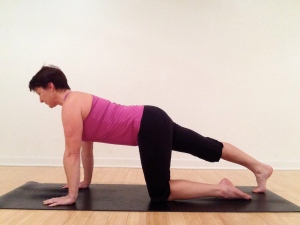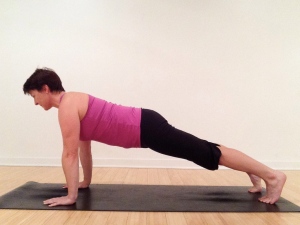We’ve completed our first set of power poses: Caturanga Dandasana, Utkatasana, and Malasana, which came together for our first peak pose of Bakasana. Hopefully, you found a new challenge or a new focus along the way. It’s time to start our second set of postures, weeks 5-8.
This week, the Power Pose is High plank. This pose is sometimes called Uttitha Caturanga Dandasana or Extended Four-Limbed Staff Pose. This posture, along with Caturanga Dandasana (yoga push-up) builds great strength and foundation, but done incorrectly can be the source of injury to the shoulder. Considering how often we find ourselves in this pose, it’s worth the time and effort to hone alignment for a safe and long-term practice.
In High Plank, the hands are employing hasta bandha or hand lock to grip the floor, the shoulders are engaged on the back, the heart reaches forward, the belly is lifted, and the legs are activated. Many times, we focus on the strength or stability of the arms, which is definitely important, but when we distribute the work of bearing the body weight among the upper body, core, and legs, high plank becomes a much more stable, integrated, and strong posture. Like many poses, the long spine is key to the energetic alignment. At the peak expression, there is one long line of energy from the heels to the crown of the head.
The engagement of the shoulders in this pose is extremely important. If you recline on your mat and tuck the shoulder blades on your back, they will be flush with the mat, so the shoulder heads can be heavy and broad. This is the same alignment needed when you are in High Plank. When in high plank, find this same pulling of the shoulder blades on the back, broad collarbone, and reaching shoulder heads. The shoulders like to creep towards the ears and create tension in the neck, so be vigilant in observing this alignment. The neck should be long and should move easily, free of tension. Try gently shaking your head “no” in high plank.
To cultivate the strength and energetic lines of this posture, try these variations:
 Option 1 – All fours. Stack the shoulders over wrists and hips over knees. Roll the shoulders away from the ears and lift the belly away from the floor. Focus on hasta bandha, the hand lock. Spread the fingers, gently grip the mat, imagine you can suction up the very middle part of your palm, just a tiny bit. Keep this activation as you breath and hold this pose.
Option 1 – All fours. Stack the shoulders over wrists and hips over knees. Roll the shoulders away from the ears and lift the belly away from the floor. Focus on hasta bandha, the hand lock. Spread the fingers, gently grip the mat, imagine you can suction up the very middle part of your palm, just a tiny bit. Keep this activation as you breath and hold this pose.
 Option 2 – Knee plank. Walk the hands forward where the shoulders are over the wrists and the body is in one long line from crown of the head to the knees. Find the activation queued in option 1, and notice if the body starts to droop or sag. This knee plank is a great way to build up wrist strength, which will eventually allow you to bear your full body weight.
Option 2 – Knee plank. Walk the hands forward where the shoulders are over the wrists and the body is in one long line from crown of the head to the knees. Find the activation queued in option 1, and notice if the body starts to droop or sag. This knee plank is a great way to build up wrist strength, which will eventually allow you to bear your full body weight.
 Option 3 – Half Plank. From knee plank, reach one foot long behind you, stacking the heel over the ball of the foot with the toes tucked. Keep the engagement of the shoulders, hands, and belly. Now add the reach of the tailbone toward the heel, lift the kneecap towards the hip, and straighten the back leg. Start to find the long line of energy from crown to heel.
Option 3 – Half Plank. From knee plank, reach one foot long behind you, stacking the heel over the ball of the foot with the toes tucked. Keep the engagement of the shoulders, hands, and belly. Now add the reach of the tailbone toward the heel, lift the kneecap towards the hip, and straighten the back leg. Start to find the long line of energy from crown to heel.
 Option 4 – High Plank. Step both feet back. Keeping the focus of the previous stages, work on equally distributing the work of bearing the full body weight among the upper body, core, and legs. Keep the gaze forward and reach the heart.
Option 4 – High Plank. Step both feet back. Keeping the focus of the previous stages, work on equally distributing the work of bearing the full body weight among the upper body, core, and legs. Keep the gaze forward and reach the heart.
A great way to build stamina in this posture, would be to choose high plank or one of it’s variants in place of a half vinyasa (caturanga dandasana, urdhva mukha svanasna, adho mukha svanasana) in your practice. Just hold plank for a few breaths and then move to Adho Mukha Svanasana (down dog). High Plank can fatigue the hands and wrists, so after practice counter the work with wrist rolls or a gentle stretch in the opposite direction.
Whatever variation or focus you work on this week, be sure to work where you feel challenged, but also where you can breath and relax around the work. Follow this weekly challenge @suzannewrightyoga on Instagram or at Suzanne Wright Yoga on Facebook. If you post your pictures or share about your experience be sure to tag #PowerPose and @suzannewrightyoga.
[…] Mukha Svanasana, Downward Facing Dog, or Down Dog shares a lot of the same alignment and energy of High Plank, which was the focus of week 5. In Down Dog, the hands are creating hasta bandha (hand lock), […]
[…] of proper alignment of the body in high plank pose with […]
[…] the posture with a long, strong, back that is free of strain. Additional full body core work like high plank pose will help create the core integration that is needed for Paripurna […]
[…] daily tasks. Many yoga poses that we practice contribute to the strength of the overall core like High Plank, Tāḍāsana, Śalabhāsana, and this week’s pose […]
[…] Core Isolation – One of the most important keys to balance is a strong core. From all fours, stack the hips over knees and shoulders over wrists. Press into the floor with the hands and knees, activating the core. Gently lift the belly and ribs away from the floor. Slowly, lift one leg behind you, keeping the foot in line with the hip and the hips level. Try not to bow or drop the belly and ribs. If you want more challenge, slowly extend the opposite arm, trying not to disturb your balance. Hold here for 5-10 rounds of breath. Repeat several rounds if you can. For an additional challenge, work up to holding full plank. […]
Helllo mate nice post